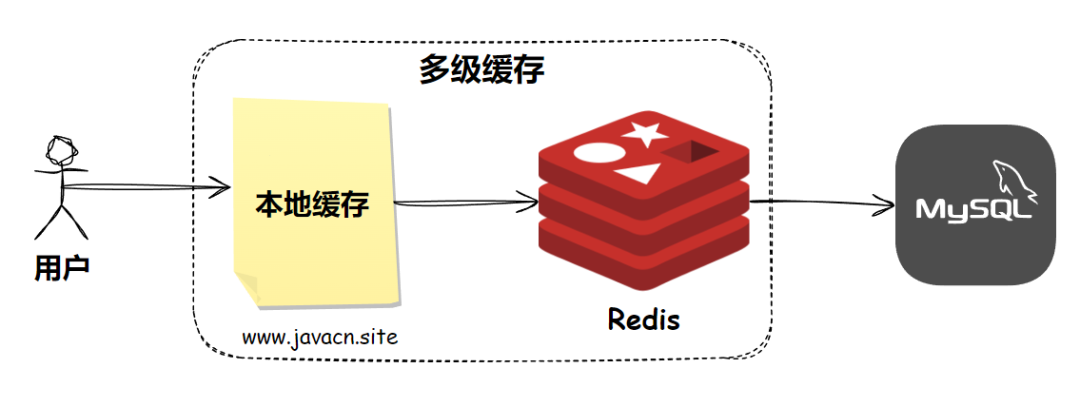本地缓存是将数据存储在应用程序所在的本地内存中的缓存方式。既然,已经有了 Redis 可以实现分布式缓存了,为什么还需要本地缓存呢?接下来,我们一起来看。
为什么需要本地缓存?
尽管已经有 Redis 缓存了,但本地缓存也是非常有必要的,因为它有以下优点:
- 速度优势:本地缓存直接利用本地内存,访问速度非常快,能够显著降低数据访问延迟。
- 减少网络开销:使用本地缓存可以减少与远程缓存(如 Redis)之间的数据交互,从而降低网络 I/O 开销。
- 降低服务器压力:本地缓存能够分担服务器的数据访问压力,提高系统的整体稳定性。
因此,在生产环境中,我们通常使用本地缓存+Redis 缓存一起组合成多级缓存,来共同保证程序的运行效率。
多级缓存
多级缓存是一种缓存架构策略,它使用多个层次的缓存来存储数据,以提高数据访问速度和系统性能,最简单的多级缓存就是由本地缓存 + Redis 分布式缓存组成的,如图所示:
 图片
图片
多级缓存在获取时的实现代码如下:
public Object getFromCache(String key) {
// 先从本地缓存中查找
Cache.ValueWrapper localCacheValue = cacheManager.getCache("localCache").get(key);
if (localCacheValue!= null) {
return localCacheValue.get();
}
// 如果本地缓存未命中,从 Redis 中查找
Object redisValue = redisTemplate.opsForValue().get(key);
if (redisValue!= null) {
// 将 Redis 中的数据放入本地缓存
cacheManager.getCache("localCache").put(key, redisValue);
return redisValue;
}
return null;
}本地缓存的实现
本地缓存常见的方式实现有以下几种:
- Ehcache
- Caffeine
- Guava Cache
它们的基本使用如下。
1.Ehcache
1.1 添加依赖
在 pom.xml 文件中添加 Ehcache 依赖:
<dependency>
<groupId>org.springframework.boot</groupId>
<artifactId>spring-boot-starter-cache</artifactId>
</dependency>
<dependency>
<groupId>org.ehcache</groupId>
<artifactId>ehcache</artifactId>
</dependency>1.2 配置 Ehcache
在 src/main/resources 目录下创建 ehcache.xml 文件:
<ehcache xmlns:xsi="http://www.w3.org/2001/XMLSchema-instance"
xsi:noNamespaceSchemaLocation="http://www.ehcache.org/ehcache.xsd">
<cache name="myCache"
maxEntriesLocalHeap="1000"
eternal="false"
timeToIdleSeconds="120"
timeToLiveSeconds="120"/>
</ehcache>1.3 启用缓存
在 Spring Boot 应用的主类或配置类上添加 @EnableCaching 注解:
import org.springframework.boot.SpringApplication;
import org.springframework.boot.autoconfigure.SpringBootApplication;
import org.springframework.cache.annotation.EnableCaching;
@SpringBootApplication
@EnableCaching
public class CacheApplication {
public static void main(String[] args) {
SpringApplication.run(CacheApplication.class, args);
}
}1.4 使用缓存
创建一个服务类并使用 @Cacheable 注解:
import org.springframework.cache.annotation.Cacheable;
import org.springframework.stereotype.Service;
@Service
public class MyService {
@Cacheable(value = "myCache", key = "#id")
public String getData(String id) {
// 模拟耗时操作
try {
Thread.sleep(1000);
} catch (InterruptedException e) {
e.printStackTrace();
}
return "Data for " + id;
}
}2.Caffeine
2.1 添加依赖
在 pom.xml 文件中添加 Caffeine 依赖:
<dependency>
<groupId>org.springframework.boot</groupId>
<artifactId>spring-boot-starter-cache</artifactId>
</dependency>
<dependency>
<groupId>com.github.ben-manes.caffeine</groupId>
<artifactId>caffeine</artifactId>
</dependency>2.2 启用缓存
在 Spring Boot 应用的主类或配置类上添加 @EnableCaching 注解:
import org.springframework.boot.SpringApplication;
import org.springframework.boot.autoconfigure.SpringBootApplication;
import org.springframework.cache.annotation.EnableCaching;
@SpringBootApplication
@EnableCaching
public class CacheApplication {
public static void main(String[] args) {
SpringApplication.run(CacheApplication.class, args);
}
}2.3 配置 Caffeine 缓存
创建一个配置类来配置 Caffeine 缓存:
import com.github.benmanes.caffeine.cache.Caffeine;
import org.springframework.cache.CacheManager;
import org.springframework.cache.caffeine.CaffeineCacheManager;
import org.springframework.context.annotation.Bean;
import org.springframework.context.annotation.Configuration;
@Configuration
public class CacheConfig {
@Bean
public CacheManager cacheManager() {
CaffeineCacheManager cacheManager = new CaffeineCacheManager("myCache");
cacheManager.setCaffeine(Caffeine.newBuilder()
.maximumSize(1000)
.expireAfterWrite(120, TimeUnit.SECONDS));
return cacheManager;
}
}2.4 使用缓存
创建一个服务类并使用 @Cacheable 注解:
import org.springframework.cache.annotation.Cacheable;
import org.springframework.stereotype.Service;
@Service
public class MyService {
@Cacheable(value = "myCache", key = "#id")
public String getData(String id) {
// 模拟耗时操作
try {
Thread.sleep(1000);
} catch (InterruptedException e) {
e.printStackTrace();
}
return "Data for " + id;
}
}3.Guava Cache
3.1 添加依赖
在 pom.xml 文件中添加 Guava 依赖:
<dependency>
<groupId>org.springframework.boot</groupId>
<artifactId>spring-boot-starter-cache</artifactId>
</dependency>
<dependency>
<groupId>com.google.guava</groupId>
<artifactId>guava</artifactId>
</dependency>3.2 启用缓存
在 Spring Boot 应用的主类或配置类上添加 @EnableCaching 注解:
import org.springframework.boot.SpringApplication;
import org.springframework.boot.autoconfigure.SpringBootApplication;
import org.springframework.cache.annotation.EnableCaching;
@SpringBootApplication
@EnableCaching
public class CacheApplication {
public static void main(String[] args) {
SpringApplication.run(CacheApplication.class, args);
}
}3.3 配置 Guava 缓存
创建一个配置类来配置 Guava 缓存:
import com.google.common.cache.CacheBuilder;
import org.springframework.cache.Cache;
import org.springframework.cache.CacheManager;
import org.springframework.cache.concurrent.ConcurrentMapCache;
import org.springframework.cache.concurrent.ConcurrentMapCacheManager;
import org.springframework.context.annotation.Bean;
import org.springframework.context.annotation.Configuration;
import java.util.concurrent.TimeUnit;
@Configuration
public class CacheConfig {
@Bean
public CacheManager cacheManager() {
ConcurrentMapCacheManager cacheManager = new ConcurrentMapCacheManager() {
@Override
protected Cache createConcurrentMapCache(String name) {
return new ConcurrentMapCache(name,
CacheBuilder.newBuilder()
.maximumSize(1000)
.expireAfterWrite(120, TimeUnit.SECONDS)
.build().asMap(), false);
}
};
return cacheManager;
}
}3.4 使用缓存
创建一个服务类并使用 @Cacheable 注解:
import org.springframework.cache.annotation.Cacheable;
import org.springframework.stereotype.Service;
@Service
public class MyService {
@Cacheable(value = "myCache", key = "#id")
public String getData(String id) {
// 模拟耗时操作
try {
Thread.sleep(1000);
} catch (InterruptedException e) {
e.printStackTrace();
}
return "Data for " + id;
}
}知识扩展:@Cacheable、@CachePut、@CacheEvict
在 Spring 框架中,@Cacheable、@CachePut 和 @CacheEvict 是用于缓存管理的注解,它们的含义如下:
- @Cacheable:用于声明一个方法的返回值是可以被缓存的。当方法被调用时,Spring Cache 会先检查缓存中是否存在相应的数据。如果存在,则直接返回缓存中的数据,避免重复执行方法;如果不存在,则执行方法并将返回值存入缓存中。它的使用示例如下:
@Cacheable(value = "users", key = "#id")
public User getUserById(String id) {
// 模拟从数据库中获取用户信息
System.out.println("Fetching user from database: " + id);
return new User(id, "User Name " + id);
}- @CachePut:用于更新缓存中的数据。与 @Cacheable 不同,@CachePut 注解的方法总是会执行,并将返回值更新到缓存中。无论缓存中是否存在相应的数据,该方法都会执行,并将新的数据存入缓存中(如果缓存中已存在数据,则覆盖它)。它的使用示例如下:
@CachePut(value = "users", key = "#user.id")
public User updateUser(User user) {
// 模拟更新数据库中的用户信息
System.out.println("Updating user in database: " + user.getId());
// 假设更新成功
return user;
}- @CacheEvict:用于删除缓存中的数据。当方法被调用时,指定的缓存项将被删除。这可以用于清除旧数据或使缓存项失效。它的使用示例如下:
@CacheEvict(value = "users", key = "#id")
public void deleteUser(String id) {
// 模拟从数据库中删除用户信息
System.out.println("Deleting user from database: " + id);
}
// 清除整个缓存,而不仅仅是特定的条目
@CacheEvict(value = "users", allEntries = true)
public void clearAllUsersCache() {
System.out.println("Clearing all users cache");
}小结
生产环境通常会使用本地缓存 + Redis 缓存,一起实现多级缓存,以提升程序的运行效率,而本地缓存的常见实现有 Ehcache、Caffeine、Guava Cache 等。然而,凡事有利就有弊,那么多级缓存最大的问题就是数据一致性问题,对于多级缓存的数据一致性问题要如何保证呢?

































